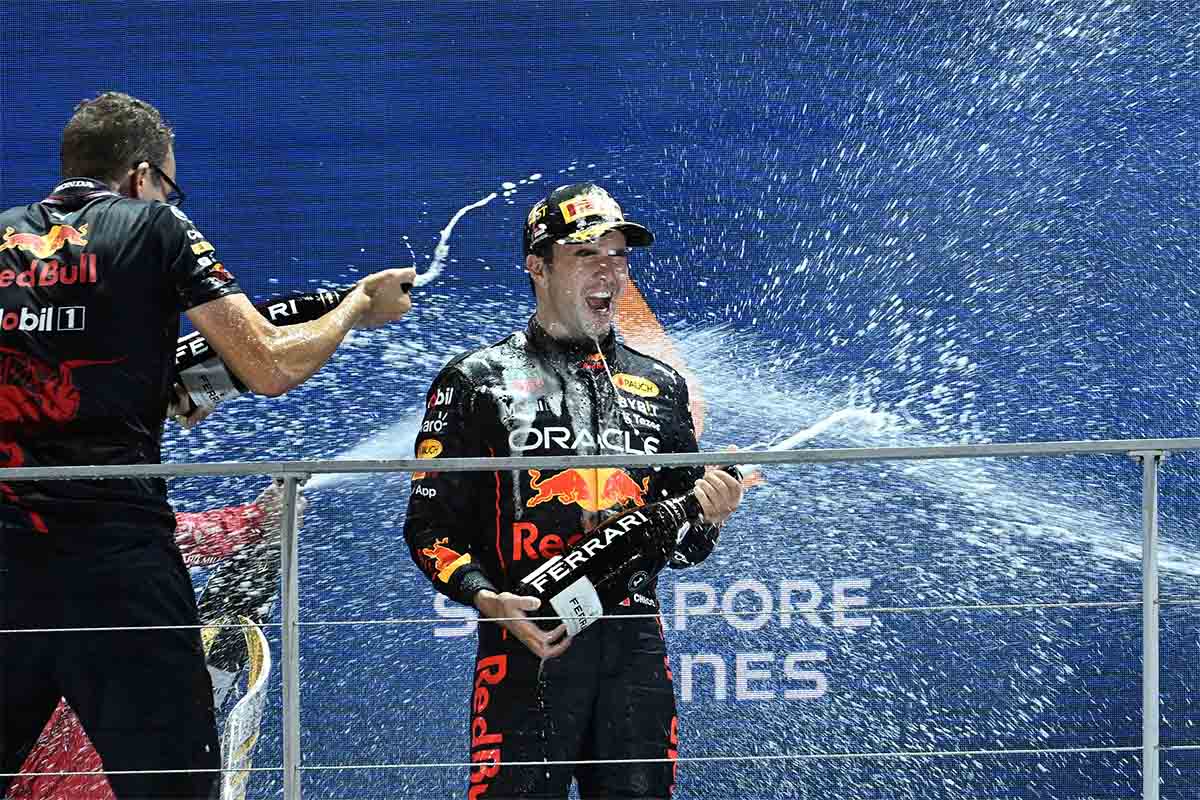What sparkling wine should be sprayed on Formula 1 winners?
Matteo Lunelli admits to being a little disappointed at times. After all, his product, considered Italy’s finest sparkling wine, can be seen in the hands of some of the world’s greatest sportsmen – who certainly looked very happy at the time – but what do- they then?
They spray it everywhere.
“I want people to taste our wines but the celebration on the podium in Formula 1 is a moment of joy, and it is a positive emotion to be associated with,” laughs Lunelli, CEO of winemaker Ferrari Trento, whose Jeroboams (3L bottles) are those who all shook themselves on the podium to mark the success of the Grand Prix. “And once they’ve done the spray, the drivers usually take it to their teams and that’s when they all start drinking. You know, we have the bubbles, so the spray works well, but I like people drinking it. Even if, as some drivers do, it comes from their own sweaty shoe.
However, being the wine thus pulverized, it is always a victory for Ferrari Trento. After all, with some 70 million people around the world watching every Grand Prix on TV and even more seeing the podium moments on social media – especially when Lewis Hamilton decides to spray the wine on the girl’s face from the nearest podium – it’s huge. , at least from an advertising point of view. And it’s a deal that requires a lot of behind-the-scenes negotiations. This is why Ferrari Trento recently extended its contract with Formula 1 until 2025, when this particular sponsorship package will once again be open to competition.
Ferrari F1 Limited Editions dedicated to Miami and Mexico
Ferrari Thirty
Lunelli will be lyrical about the synergy of values between his brand and Formula 1 – the pursuit of excellence, the passion for craftsmanship, the importance of innovation, etc. And yes, since Italy is synonymous with luxury sports car manufacturing, it’s a nice touch to have an Italian wine to sit alongside all the Pirelli tires, Kappa and Giorgio Armani uniforms and engineering Alfa Romeo. Indeed, if you’re Italian, you’ll probably already associate the Ferrari Trento with being the toast of other major sporting events, like the Luna Rossa Prada Pirelli yacht racing team for the America’s Cup, the Juventus football club and the Italian Tennis Open. tournament. For many years, it was also the official toast of the Emmy Awards.
But it’s ultimately a strategic decision: the increasingly bustling Formula 1 is looking for a company that can supply large volumes of high-quality wine. As Lunelli points out, racing aside, Formula 1 is a juggernaut of corporate hospitality, commanding high ticket prices for high rollers, so quality matters. No doubt eager to assess the wares of the 2020 Sparkling Wine Producer of the Year at the Champagne and Sparkling Wine World Championships, the Formula 1 team took care to conduct drink tastings of Ferrari Trento… although she did not assess its spray ability. . And in choosing Ferrari Trento for its hospitality, he also chose a sparkling wine, rather than the more traditional Champagne.

Meanwhile, Ferrari Trento – which will provide plenty of free wine as part of the deal, but will also sell some 60,000 bottles at Grand Prix events during the 2022 season – sees Formula 1 as the launch pad. ideal world for a wine that is a household name in Italy, but needs to make more noise abroad. Ferrari Trento has not received details of the other winemakers vying for the prestigious slot, but Lunelli says there were plenty of them.
“Of course, we have long thought of Formula 1 as an incredible opportunity for us and it is a very important investment for us, especially because [those podium moments] are among the most iconic moments in the world of sport,” says Lunelli, who entered lengthy negotiations with Formula 1 in 2019. “The competition [for the sponsorship deal] It wasn’t just about who could pay the most, but about providing the right standard of product. But you don’t know who you’re up against or what they’re offering you. The case was not easy [to pull off] but we succeeded. Formula 1 [sponsorship] the team was very demanding.
The history of Formula 1 champagne
Other brands have already been there: for more than 30 years it was Moet & Chandon, followed by a 15-year run for GH Mumm, two well-established brands in the world long before Formula 1 took hold. exist. Lesser known, Argentinian sparkling Chandon was the sprayer of choice for two years, before industry newcomer Champagne Carbon won the contract. They also saw the marketing potential of the tradition; GH Mumm has even added an extra upside-down label to the supplied bottles so that the brand name remains easily readable when drivers turn them upside down to drink.
Indeed, the first example of a connection between champagne and the podium dates back to the creation of Formula 1 in 1950, when Moet & Chandon donated a bottle to Argentine racing legend Juan Manuel Fangio; he was the winner of the French Grand Prix that year, held at the Gueux circuit in Reims, in the heart of Champagne territory. Spraying it, however, was quite another thing. The story goes that when Swiss driver Jo Siffert received his bottle as the winner of the 1966 24 Hours of Le Mans race, he had been sitting in the sun and the cork popped off on its own, dousing those who were nearby in the process.
What a good idea, thought the American pilot Dan Gurney, winner of the race the following year. He became the first driver to deliberately spray a bottle of celebratory champagne; he was, as he once described, “Beyond attention and just caught up in the moment.” In the process, he created a tradition.
A few caveats to tradition: the champagne is not opened, much less sprinkled if a driver has been killed or seriously injured during the race. And in countries where alcohol consumption is restricted, particularly in the Middle East, sparkling fruit juice or rose water is the usual replacement, although Mercedes team boss Toto Wolff has claimed that at the Turkish Grand Prix in 2020, it was Sprite.
It has even become a political statement on occasion. When Michael Schumacher and Rubens Barrichello found themselves on the podium at the United States Grand Prix in 2005 – a problematic event in many ways – they simply toasted and drove off, leaving third-placed driver Tiago Monteiro unaware that he enjoyed the only podium of his career, to pulverize at will.
“I think spraying wine like this works precisely [in the context of the podium] because popping the cork itself is an action that creates energy. It’s something joyful in itself,” says Lunelli. “You know, that’s the whole idea of the bubbles. The bubbles are happy, they move on their own, they have no order. Opening a bottle and seeing those bubbles is like seeing a wine clap your hands.
Ferrari Trento enters the world stage
But can he put Ferrari Trento on the international map? As Lunelli concedes, “Compared to other brands in the world of Formula 1, we are very small. So keeping up with the pace set by Formula 1 will be a challenge.” And, he adds, not everyone watching the races on TV “will pay attention to every detail of the podium celebration. But, you know, the bottle tends to be a strong protagonist in these moments,” noting that since 2017, a “bottle camera” is even attached to it. And Formula 1 also offers the opportunity for thousands of people to try these wines, perhaps for the first time.
Ferrari Trento was quick to produce a limited edition Jeroboam which is an exact replica of the one used on the Formula 1 podium. It is sold out. Other special editions, tied to specific race tracks – Monza, Silverstone, Mexico City and now Miami – have followed, with more in the pipeline. In other words, Ferrari Trento misses no opportunity to bring the association with Formula 1 home.
There’s even, well, that name. Some of you might know another Ferrari, car manufacturer or something like that… But actually both Ferraris go way back, with the Ferrari Trento also being used at Ferrari events: when Enzo Ferrari tied this relationship for the first time, he pointedly pointed out that the distinction between the two marks is clear, given that Italian grammar has car as feminine (the Ferrari) and wine in the masculine (the Ferrari).
“In Italy, Ferrari is a common name. And of course we are happy to share this name with such fantastic cars. We don’t want to create confusion, but often people think we’re something to do with the car and then lean into it, so the name creates curiosity,” says Lunelli. “Of course, we know that people all over the world, when they think of the name Ferrari, probably think of the car and not of a sparkling wine producer.”
But with this unusual F1 tradition, that may change.
This article was published in the Inside hook newsletter. Register now.


Comments are closed.